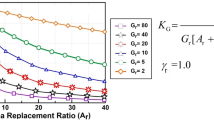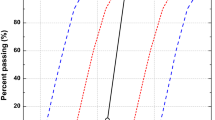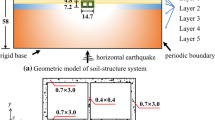Abstract
This paper presents the result of two-dimensional finite element modeling studies in order to investigate the seismic behavior of high modulus columns in liquefiable soil. Particular attention was paid to the shear stress reduction mechanism of the high modulus columns and the shear strain distribution between soil and columns during earthquake motion. Numerical analyses were performed using a nonlinear elasto-plastic model in Plaxis 2016. The reliability of the numerical simulations was verified through the results of a centrifuge test model designed to investigate the contribution of high modulus columns in liquefaction mitigation. The capability of numerical simulations was assessed primarily through comparison of predicted acceleration-time histories, pore water pressures, and displacements with the measured counterparts. The results of the numerical analysis showed that the presence of the columns did not reduce seismic shear stresses in the soil when compared to the unimproved soil condition and pure shear behavior between soil and column did not develop as expected in the current design methodology.
Similar content being viewed by others
References
Adalier K, Elgamal A, Meneses J and Baez JI (2003), “Stone Columns as Liquefaction Countermeasure in Non-Plastic Silty Soils,” Soil Dynamics Earthquake Engineering, 23(7): 571–584.
Arulmoli K, Muraleetharan KK, Hossain MM and Fruth LS (1992), “VELACS: Verification of Liquefaction Analyses by Centrifuge Studies, Laboratory Testing Program,” Soil Data Report, Project No. 90-0562, The Earth Technology Corporation, Irvine, California.
Baez JI and Martin GR (1993), “Advances in the Design of Vibro Systems for the Improvement of Liquefaction Resistance,” Proceedings of 7th Annual Symposium of Ground Improvement, Canadian Geotechnical Society, Vancouver, BC, Canada.
Baez JI (1995), “A Design Model for the Reduction of Soil Liquefaction by Using Vibro-Granular Columns,” Ph.D. Thesis, University of Southern California, Los Angeles.
Beaty MH and Byrne PM (2011), “UBCSAND Constitutive Model Version 904aR,” Documentation Report, UBCSAND Constitutive Model on Itasca UDM Website: http://www.itasca.udm.com/media/download/UBCSand/UBCSAND_UDM_Documentation.pdf.
Galavi V, Petalas A and Brinkgreve RBJ (2013), “Finite Element Modelling of Seismic Liquefaction in Soils,” Geotechnical Engineering Journal of the SEAGS & AGSSEA, 44(3): 55–64.
Goughnour RR and Pestana JM (1998), “Mechanical Behavior of Stone Columns under Seismic Loading,” Proceedings of 2nd International Conference on Ground Improvement Techniques, CI-Premier, Singapore, 157–162.
Green RA, Olgun CG and Wissmann KJ (2008), “Shear Stress Redistribution as a Mechanism to Mitigate the Risk of Liquefaction,” Proceedings of Geotechnical Earthquake Engineering and Soil Dynamics IV, ASCE, Reston, VA, GSP 181.
Idriss IM and Boulanger RW (2008), “Soil Liquefaction during Earthquakes,” Monograph MNO-12, Earthquake Engineering Research Institute, Berkeley, CA.
Kammerer A, Wu J, Riemer M, Pestana J and Seed R (2004), “A New Multi Directional Simple Shear Testing Database,” Proceedings of 13th World Conference on Earthquake Engineering, Vancouver, Canada, No. 2083.
Kuhlemeyer and Lysmer (1973), “Finite Element Method Accuracy for Wave Propagation Problems,” Journal of Soil Mechanics and Foundations Division, 99(5): 421–427.
Kumari S, Sawant VA and Mehndiratta S (2018), “Effectiveness of Stone Column in Liquefaction Mitigation,” Proceedings of Geotechnical Earthquake Engineering and Soil Dynamics V, ASCE, Austin, Texas, GSP 290.
Laera A and Brinkgreve RBJ (2015), “Site Response Analysis and Liquefaction Evaluation,” Plaxis Knowledge Base.
Makra A (2013), “Evaluation of the UBC3D-PLM Constitutive Model for Prediction of Earthquake Induced Liquefaction on Embankment Dams,” M.Sc. Thesis, Delft University of Technology, Delft.
Martin JR, Olgun CG, Mitchell JK and Durgunoglu HT (2004), “High-Modulus Columns for Liquefaction Mitigation,” Journal of Geotechnical and Geoenvironmental Engineering, 10.1061/(ASCE)1090-0241, 130(6): 561–571.
Mitchell JK and Wentz FL (1991), “Performance of Improved Ground during the Loma Prieta Earthquake,” Rep. No. UCB/EERC-91/12, University of California, Berkeley, CA.
Olgun CG and Martin JR (2008), “Numerical Modeling of the Seismic Response of Columnar Reinforced Ground,” Proceedings of Geotechnical Earthquake Engineering and Soil Dynamics IV, ASCE, Reston, VA.
Petalas A and Galavi V (2013), “Plaxis Liquefaction Model UBC3D-PLM,” Plaxis Report.
Puebla H, Byrne PM and Philips R (1997), “Analysis of CANLEX Liquefaction Embankments: Prototype and Centrifuge Models,” Canadian Geotechnical Journal, 34(5): 641–657.
Rayamajhi D, Nguyen T, Ashford S, Boulanger R, Lu J, Elgamal A and Shao L (2014), “Numerical Study of Shear Stress Distribution for Discrete Columns in Liquefiable Soils,” Journal of Geotechnical and Geoenvironmental Engineering, ASCE, 140(3): 04013034.
Rayamajhi D, Tamura S, Khosravi M, Boulanger RW, Wilson DW, Ashford SA and Olgun CG (2015), “Dynamic Centrifuge Tests to Evaluate Reinforcing Mechanisms of Soil-Cement Columns in Liquefiable Sand,” Journal of Geotechnical and Geoenvironmental Engineering, ASCE, 141(6): 04015015.
Rayamajhi D, Ashford SA, Boulanger RW and Elgamal A (2016), “Dense Granular Columns in Liquefiable Soils: Shear Reinforcement and Cyclic Stress Ratio Reductions,” Journal of Geotechnical and Geoenvironmental Engineering, ASCE, 142(7): 04016023
Shenthan T, Nashed R, Thevanayagam S and Martin GR (2004), “Liquefaction Mitigation in Silty Soils Using Composite Stone Columns and Dynamic Compaction,” Earthquake Engineering and Engineering Vibration, 3(1): 39–50.
Tan SA, Tjahyono S and Oo KK (2008), “Simplified Plane-Strain Modeling of Stone-Column Reinforced Ground,” Journal of Geotechnical and Geoenvironmental Engineering, ASCE, 134(2): 185–194.
Tang L, Zhang X, Ling X, Li H and Ju N (2016), “Experimental and Numerical Investigation on the Dynamic Response of Pile Group in Liquefying Ground,” Earthquake Engineering and Engineering Vibration, 15(1): 103–114.
Tsegaye A (2010), “Plaxis Liquefaction Model,” Report No. 1, Plaxis Knowledgebase.
Wissmann KJ, van Ballegooy S, Metcalfe BC, Dismuke JN and Anderson CK (2015), “Rammed Aggregate Pier Ground Improvement as a Liquefaction Mitigation Method in Sandy and Silty Soils,” Proceedings of the 6th International Conference on Earthquake Geotechnical Engineering, Christchurch, New Zealand.
Zhou Y, Sun Z, Chen J, Chen Y and Chen R (2017), “Shear Wave Velocity-Based Evaluation and Design of Stone Column Improved Ground for Liquefaction Mitigation,” Earthquake Engineering and Engineering Vibration, 16(2): 247–261.
Author information
Authors and Affiliations
Corresponding author
Rights and permissions
About this article
Cite this article
Demir, S., Özener, P. Numerical investigation of seismic performance of high modulus columns under earthquake loading. Earthq. Eng. Eng. Vib. 18, 811–822 (2019). https://doi.org/10.1007/s11803-019-0537-2
Received:
Accepted:
Published:
Issue Date:
DOI: https://doi.org/10.1007/s11803-019-0537-2




